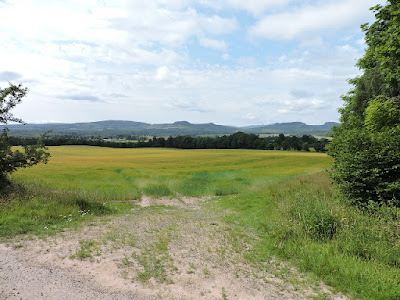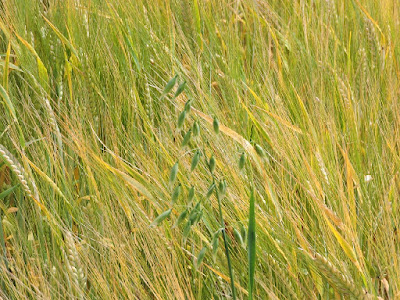SEE YER, BRAHAN
Things are still relaxed enough on the Covid front for us to go for another walk in the countryside. This time we went to Brahan. We have been here before, but had not done this particular walk.
It being our walk, we arrived in plenty of time with Maureen and Pam as their usual chauffeurs were unable to take them. We had a bit of time to spend watching for all the others to arrive.
Soon, the Smiths and the Marwicks had arrived.
That just left Agnes, she would be here soon, especially as Sharon had spoken to her earlier in the morning to confirm the meeting point. What could possibly go wrong?
Quite a lot, it would seem. Agnes had assumed that following the road from the Maryburgh roundabout towards Garve, meant that she should actually drive to Garve and, indeed, onwards towards Ullapool. This was not an away weekend we were going on! She had phoned before she got to the west coast and so, Sharon went up to the Brahan junction to await her arrival.
Still the ensuing delay allowed us to look at these intriguing structures.
Jimmy was sure that these were used for stacking haystacks and that the mushroom shape was to stop rats from climbing up into the stacks. He is quite old and wise and he was completely correct!
These were made by a company called Gibson and Son from Edinburgh. They are so famous in the corn rick stand business, that they have a page to themselves in the Scottish Agricultural Implement Makers website! They were a very big name in the wrought iron stool stacks business. These were made to slot together in an octagon and the mushroom shape stopped rats climbing up and the whole corn rick was kept off the ground.
The company started in 1868 as Gibson and Tait, but that was dissolved and Gibson set up business with his son. They were frequent award winners at the Highland Show for their field gates and sheep pens! They stopped making these corn rick stools in 1919, so these ones are over 100 years old.
This is a completed stack using the wrought iron stools at the Strathnairn Farmers' Association Working Vintage Rally and Display in 2014. If you wanted to see a proper Gibson stool in action, there is one at the Highland Folk Museum in Newtonmore.
Still no sign of Agnes! It was quicker for me to find out about corn rick stools than it took for Agnes to find her way to the start of the walk!
As all good things come to those who wait, so Agnes arrived. Just as well, really, Pam was off!
Luckily, Sharon and Jimmy waited for Agnes, otherwise she might have got lost again.
It was a lovely, warm day and there were some nice views to be had.
An old water pump next to Balnain Farm.
Just beyond Balnain, we could see out to the Cromarty Bridge, a good 6 miles away.
Jacque had found a green spider. I, for one, cannot recall ever seeing a green spider before. It looks like a green orb weaver spider and is, in fact, a common spider found throughout the UK. I guess we will just need to be a bit more observant the next time we are out and about.
Next stop was the rather rickety looking bridge across to Dunglass Island. Dunglass would translate as land of the grey fortress and there is reputed to be an Iron Age fort on the island, but that does not appear on any sources that I can find.
We sent Jimmy over first!
Looking downstream from the bridge. Looks like any other river, but Dunglass Island lies only 6 to 8 metres above sea level. The River Conon is actually tidal almost up to the island.
Dunglass Island extends to over 40 hectares, which means it is one of the largest freshwater islands in Scotland - there are only 16 islands of this type over 35 hectares in size.
It flooded badly in 1892, so much so, that it was covered in a thick layer of mud and gravel that was thought to have rendered over half of it unfit for ploughing and cultivation.
There is plenty that is cultivated now, though.
A rogue stalk of oats in an ocean of barley. There was a bit of debate over whether it was barley or wheat. The key difference is that barley has a long beard, whereas, wheat doesn't. Rye can be confused with barley, but is less commonly grown up here.
Oats do not grow in spikes like wheat and barley, nor do they contain gluten, but you can't tell that just by looking at the seeds!
There was a lot of Himalayan Balsam on the island. This was introduced to the UK in 1839 and has invaded the whole of the country since then. It is very invasive and highly tolerant of shade. It outcompetes and shades out native species and is one of the most destructive plants in the countryside. Having said that, it is also the most prolific nectar producing plant in Britain, so is highly useful to bees. Of course, once pollinated it forms seeds and each plant can produce up to 800 of these which it can shoot out of the seed pods for a distance of over 20 feet. It is easy to see why it can be so invasive.
Walking through fields of gold.
Some parts of the island have been planted with forage and cover for birds. These blue flowers are Phacelia or fiddlenecks, a type of borage, which is very attractive to insects.
It was all very bucolic walking through this variety of flowering plants.
We soon came to the other side of the island and everybody promptly sat down on the riverbank. And, why not?
We dragged them back to their feet, so that we could get to the little fishing hut further on, where we had planned to have lunch.
From where we were sitting it looked like we could walk on top of the weir and get to the run of river hydro plant. When we had checked out the walk, you could not do that due to water levels. This would take about a mile off the walk and, surprisingly, everyone voted for that option.
So, off we went.
I'm not sure if the majority of the party stayed behind to let Jimmy and I find out of this route was possible, thus saving them the possibility of finding there was no way through, requiring a retracing of our steps.
Of course, it was possible and we were soon at the power station. The hydro scheme here operates on a very low level of head - less than 1.5 metres and it generates 100kilowatts of power from the twin Archimedes screws. The power is used by the farm and excess is sold to the grid.
After the power, comes the glory.
A small tortoiseshell butterfly. The Gaelic for butterfly is dealan-de meaning fire of God. Butterflies were once sacred and thought to carry the souls of the dead to heaven. It is good luck to see them near the house of someone who is dead or dying! I expect the person at death's door might see it a bit differently.
The Conon is a well known salmon river, but I think this treble hook is a bit on the big side even for a famous river like this.
There is a fish ladder at the side of the screws to let salmon pass up beyond the scheme.
Not a bridge photo, but a power pose.
Along the beaten track.
Off the beaten track.
A group of horses, including some young foals. Now, I was thinking about what to call this group of horses. Herd just didn't seem right here. Apparently there are heaps of collective nouns for horses and you could choose whichever suited your purpose. A bit like a remuda, which is a herd of horses which have been saddle broken and from which ranch hands would pick their mount for the day.
You could also have a harass of horses. These look a bit like ponies to me and they are a bit orange, so a marmalade of ponies, might do the trick.
If they had been unicorns, they would be a blessing!
From horses to chickens. This bracket fungus looks to me like Chicken of the Woods or, as it is less commonly known, Laetiporus sulphureus. It is edible, but only when young. I'm not willing to say that I was entirely doubt free on identification, so I won't be trying it out with my scrambled eggs.
We emerged, blinking, into the sunshine after a shady walk in the woods.
A pair of speckled wood butterflies, pretending, unsuccessfully, to be leaves.
Along the edge of the woods we walked.
Until we came to a clearing and a meeting of paths.
Luckily we knew where we were going and chose a path to follow.
It took us to a large pond, with two swans sitting on the bank.
Alongside the swans were the cygnets. Swans are known to be very protective of their young and we walked gingerly past, without any incident, although the swans seemed a little edgy.
There were lots of common blue damselflies at the edge of the pond. If you are unsure whether an insect is a dragonfly or a damselfly, wait until it lands. If it folds its wings back along the body line it is a damselfly. Dragonflies hold their wings out at right angles.
It is a very pretty and calming spot here.
It is difficult not to just sit and take it all in.
But, we had to leave - tea and cakes were calling.
It was back to our house for a welcome cup of something and something sweet to go along with it. There were some interlopers who did not go through the rigours of the walk, but managed to get tea and cakes - Hugh, Robin, Megan and Susan would be the culprits.
Megan's twin sister managed to get to the other end of the table, where she managed another bit of cake, I think.
Agnes, meanwhile, had managed to get lost on the way to our house and ended up back at home enjoying a gin with Richie.
Cheers, everyone!





















































